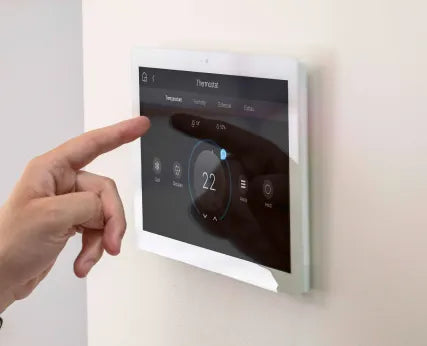Walk into any modern retail store, corporate office, or bustling transit hub, and you'll see them: vibrant, moving screens displaying everything from promotional videos to real-time data. This is the world of digital signage, a powerful communication tool that has moved far beyond simple "now serving" displays. It’s about creating experiences, driving behavior, and delivering measurable results.
But what separates a screen that gets ignored from one that captivates and converts? The answer lies in a smart strategy that blends the right hardware, intuitive software, and compelling content. This guide will walk you through everything you need to know to transform your spaces with effective digital signage solutions, turning passive viewers into active participants.
What Exactly Is Digital Signage?
At its core, digital signage uses commercial displays—like LCD, LED, or projection screens—to showcase dynamic content such as videos, graphics, and interactive elements. Unlike a static poster, this content can be updated in real-time from a central location using a content management system (CMS). This capability unlocks a world of possibilities for timely, relevant, and engaging communication.
Think of it as your own private broadcast network, tailored specifically to the people in your physical locations.
Why Digital Signage Matters More Than Ever
The shift from static to digital is not just a trend; it's a response to changing consumer expectations. People are accustomed to the interactive, personalized nature of their smartphones, and they expect a similar level of engagement from the brands and organizations they interact with in the physical world.
Dynamic visuals simply perform better. They capture more attention, improve message recall, and can significantly lift sales and engagement rates compared to print. The ability to remotely manage content across hundreds of screens also offers incredible efficiency and consistency, eliminating the costs and delays of printing and distributing physical materials.
Key Applications: Digital Signage in Action
Digital signage is not a one-size-fits-all solution. Its power is in its adaptability across various industries.
Retail Digital Signage: Crafting the Customer Journey
In retail, screens are a core part of the in-store experience. They bridge the gap between your online presence and your physical footprint.
- Video Walls: Create stunning, high-impact "wow" moments at store entrances.
- Interactive Kiosks: Allow shoppers to browse endless aisles, check inventory, or order out-of-stock items.
- Promotional Displays: Highlight sales, new arrivals, and loyalty program benefits right at the point of decision.
- Pro Tip: Use QR codes on your retail digital signage to link to product pages, reviews, or special mobile coupons, directly connecting the physical display to a customer's device.
Restaurants & QSR: Modernizing the Menu Board
For quick-service restaurants, digital menu boards are a game-changer.
- Dynamic Pricing: Easily update prices and promote daily specials or combo deals.
- Dayparting: Automatically switch from breakfast to lunch to dinner menus at scheduled times.
- Nutritional Information: Display calorie counts and allergen information to comply with regulations and inform customers.
Corporate Communications: Engaging the Modern Workforce
In the corporate world, digital signage helps unify a dispersed workforce and strengthen company culture.
- Welcome Screens: Greet visitors and employees with a professional, branded message.
- Data Dashboards: Display real-time KPIs, sales targets, and project milestones to keep teams aligned.
- Meeting Room Displays: Show room availability and schedules to prevent booking conflicts.
- Internal Communications: Share company news, celebrate employee achievements, and broadcast CEO town halls.
- Quick Poll: How would your team feel about seeing live progress toward goals on a screen in the office? This is a great way to boost motivation.
Healthcare: Improving the Patient Experience
In hospitals and clinics, clear communication is critical.
- Wayfinding: Interactive maps on touch screens help patients and visitors navigate complex facilities, reducing stress and missed appointments.
- Waiting Room Education: Share health tips, introduce doctors, and manage expectations about wait times to reduce perceived dwell time.
- Staff Communication: Display critical alerts, surgical schedules, and on-call rosters in staff-only areas.
Education: Connecting the Campus
From K-12 to higher education, LED displays and interactive screens connect students and faculty.
- Event Promotion: Announce sporting events, club meetings, and campus activities.
- Emergency Alerts: Instantly broadcast critical safety information across the entire campus.
- Donor Recognition: Create dynamic displays to thank alumni and donors for their contributions.
The Building Blocks: Hardware and Software
A successful digital signage network has two key components: the physical hardware that audiences see and the powerful software that runs the show behind the scenes.
Hardware Essentials
- Commercial Displays: These are built for 24/7 operation and are brighter and more durable than consumer TVs. The choice between LCD and LED displays often depends on viewing distance and environment (indoor vs. outdoor).
- Media Players: These small computers feed content to the screens. They can be external devices or built directly into the display (System-on-Chip or SoC).
- Mounts & Enclosures: Securely mounting your screens is crucial for safety and aesthetics. Enclosures protect displays in public or outdoor environments from weather and tampering.
The Brains of the Operation: The CMS
The content management system (CMS) is where the magic happens. A robust CMS allows you to:
- Schedule Content: Plan what plays, where, and when—down to the minute.
- Manage Your Network: Use remote device management to monitor screen health, reboot players, and troubleshoot issues from anywhere.
- Use Templates: Ensure brand consistency with locked-down templates that non-technical staff can easily update.
- Set User Permissions: Control who can upload, edit, and publish content.
- Integrate Data: Pull in live data from other systems, like social media feeds, weather forecasts, or sales dashboards.
CTA: Linko Smart Technology's CMS is designed for both power and simplicity. Ask us for a live demo to see it in action!
Best Practices for Content That Captivates
Great hardware is nothing without great content. Your message has only a few seconds to grab attention.
- Motion is Key: The human eye is drawn to movement. Even subtle animations can make a display 10x more effective.
- Clarity Over Clutter: Keep text minimal and legible. Use bold, large fonts and high-contrast color schemes. A good rule of thumb: can it be read from 10 feet away in 3 seconds?
- Clear Call to Action (CTA): Tell the viewer what to do next. "Scan the QR code," "Visit us on the 3rd floor," or "Ask a sales associate for details."
- Context is Everything: Tailor your content to the screen's location and the audience's mindset. A message in a breakroom should be different from one at a point of sale.
Your Digital Signage Deployment Checklist
Ready to get started? A successful rollout requires careful planning.
- Site Survey: Assess each location. Where are the high-traffic areas? What are the viewing angles and distances?
- Infrastructure Check: Confirm access to reliable power and internet (wired or Wi-Fi).
- Hardware Selection: Choose the right screen size, type, and media player for each location's needs.
- Mounting & Installation: Plan for secure, professional installation that complies with all safety codes.
- Content Strategy: Define your goals and create a content plan before the screens go up.
- Training: Ensure your team knows how to use the CMS to manage content effectively.
Measuring Success: From Eyeballs to ROI
How do you know if your investment is paying off? Measuring the ROI of digital signage involves looking beyond simple viewership.
- Key Performance Indicators (KPIs): Track metrics relevant to your goals. This could be an increase in sales for a promoted item, a reduction in perceived wait times, or higher employee engagement survey scores.
- Audience Analytics: Use camera-based technology (with privacy protections) to gather anonymous data on viewer demographics, dwell time, and attention rates.
- A/B Testing: Test different messages, layouts, or CTAs on different screens to see what performs best.
- Interaction Tracking: On touch screens, measure taps, content views, and task completion rates. For QR codes and NFC, track scan rates and subsequent mobile engagement.
By setting clear goals and tracking the right metrics, you can prove the value of your digital signage and continually optimize its performance.
The Future of Digital Signage is Smart
The technology is evolving quickly, moving toward more personalized and automated experiences.
- AI and Personalization: Signage will use anonymous analytics to dynamically change content based on the viewer's likely demographic (e.g., showing a different ad to a millennial female vs. a baby boomer male).
- Programmatic DOOH: The buying and selling of digital-out-of-home (DOOH advertising) inventory is becoming automated, allowing for hyper-targeted, real-time ad campaigns.
- Deeper Interactivity: Beyond touch, screens will respond to gestures, voice commands, and even mobile phone proximity.
Partner with Linko Smart Technology
Deploying a successful digital signage network involves much more than just hanging a screen on a wall. It requires a holistic strategy encompassing hardware, software, content, and analytics.
At Linko Smart Technology, we are experts in creating end-to-end digital signage solutions that deliver results. We partner with you from initial strategy and site surveys to installation, content creation, and ongoing support.
Ready to bring your spaces to life? Contact Linko Smart Technology today for a complimentary consultation or to schedule a pilot program.
Frequently Asked Questions (FAQ)
1. How much does a digital signage solution cost?
The cost varies widely based on the scope of the project, including the number and type of screens, software licensing, and installation complexity. We focus on value and ROI, designing solutions that fit your budget and goals. Contact us for a custom quote.
2. How long does installation take?
A simple, single-screen installation can be done in a day. A large-scale, multi-location rollout requires more extensive planning and can take several weeks. We develop a clear project timeline upfront so you know exactly what to expect.
3. We don't have a graphic designer. How do we create content?
No problem! Our CMS includes a library of professionally designed, easy-to-edit templates. We also offer full content creation services, from graphic design and animation to video production, to ensure your screens always look fresh and professional.
4. What are the maintenance requirements?
Our commercial-grade hardware is built for longevity. The primary maintenance is done remotely through our CMS, where we monitor system health and perform software updates. We also offer onsite support plans for hardware issues.
5. How do we ensure our content is accessible and compliant?
We can guide you on best practices for accessibility, such as using high-contrast colors, legible fonts, and providing non-visual alternatives for interactive content. For regulated industries like healthcare and finance, our platform supports workflows to ensure all content is approved before being published.




